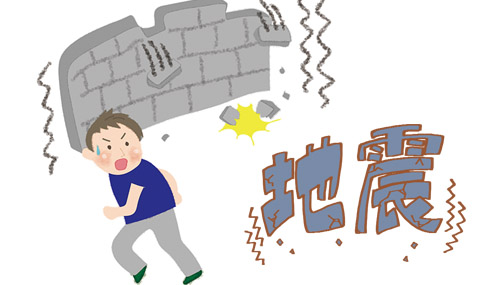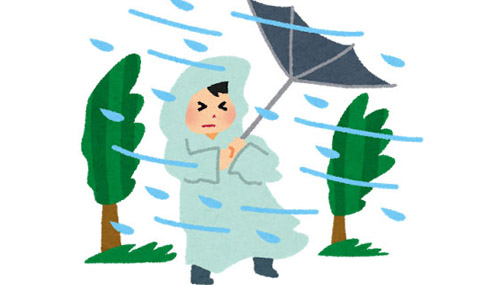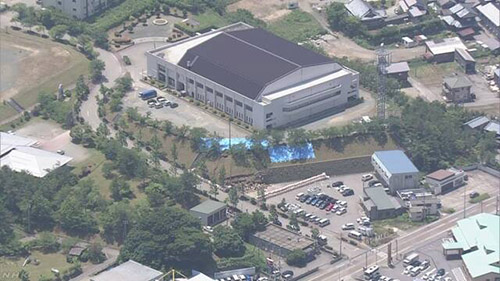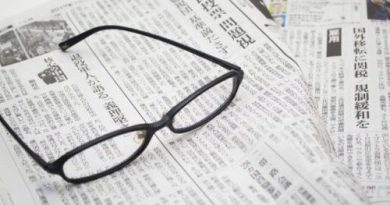Learn to read Japanese newspaper on Meteorology and disaster
In this section of Japanese newspapers reading practice, we would like to introduce how to Learn to read Japanese newspaper on Meteorology and disaster – one of the extremely “hot” field in Japan.
Contents
Instruction
In order to read Japanese articles on topic : meteorology and disaster, you can go to Japanese online newspapers such as: NHK News, Biglobe News… and select categories 気象・災害 (Kishou – Saigai: Meteorology – Disaster).

How to practice reading : just like the instructions in previous topics, first, you should skim the article to get the main idea, then note down unknown words or unknown sentences and look up the dictionary to clarify the meaning of each sentence. With higher level sentences that you have not learned yet, skip it to avoid disturbing the knowledge.
Vocabulary on meteorology and disaster in Japanese newspapers
避難場所 (Hinan basho): Evacuation location
防災 (Bousai): Disaster prevention
警報 (Keihou): Alarm, warning
気象庁 (Kishouchou): Meteorological agency
竜巻 (Tatsumaki): Tornado
落雷 (Rakurai): Lighting
津波 (Tsunami): Tsunami
突風 (Toppuu): The sudden whirlwind
降る雨の量 (Furu ame no ryou): Amount of rain
震度 (Shindo): Seismic intensity
余震 (Yoshin): Aftershock
マグニチュード (Magunichuudo): Earthquake scale measurement unit (Magnitude)
激しい揺れ (Hageshii yure): Vibrant shaking
崩落 (Houraku): Crash collapsed
水漏れ (Mizumore): Water leak
天気が急変する (Tenki ga kyuuhen suru): The weather changes suddenly
観測する (Kansoku suru): Monitoring and measuring
地盤が緩む (Jiban ga yurumu): The ground becomes soft
影響する (Eikyou suru): Impact
地震が起きる (Jishin ga okiru): An earthquake occurred
被害を受ける (Higai wo ukeru): Suffer
Some Grammar structures found in category : meteorology and disaster in Japanese newspapers

Sentence 1
Nの、Vる + おそれがある: There is fear that. . .
これから20日夜遅くにかけて局地的に積乱雲が発達し、雷を伴って1時間に30ミリ以上の激しい雨が降るおそれがあります。
Korekara 20 nichi ya osoku ni kakete kyokuchiteki ni sekiranun ga hattatsu shi, kaminari wo tomonatte 1 jikan ni 30 miri ijou no hageshii amegafuru osore ga arimasu.
From now until late at night on the 20th, the cumulonimbus clouds will develop locally and there will likely rain heavily over 30mm in about 1 hour with thunder.
Sentence 2
(Vる/Vない) + よう(に) + V(注意する/呼びかける): to remind, to ask
帰宅時間帯に天気が急変するおそれもあり、気象庁は低い土地の浸水などに十分注意するよう呼び掛けています。
Kitaku jikantai ni tenki ga kyuuhen suru 0 sore mo an, Kishouchou wa hikui tochi no shinsui nado ni juubun chuui suru you yobikakete imasu.
It is likely that the weather will change abruptly on the way back to home, so the Meteorological Department urged people to pay attention to flooded areas.
Sentence 3
Causative form
Verb group 1:う➞あ + せる
Verb group 2:る + させれ
Verb group 3:する➞させる、来る来させる
大岩川地区の140棟も一部で調査を始めて20日中に終わらせ、そのほかの被害が大きい地域についても調査を進めていくことにしています。
Ooiwagawa chiku no 140 mune mo ichibu de chousa wo hajimete 20 nichi chuu ni owarase, sono hoka no higai ga ookii chiiki ni tsuite mo chousa wo susumete iku koto ni shiteimasu.
Beginning the investigation at about 140 buildings in the Ooiwagawa area and will be completed in the 20th, and also trying to continue the investigation for other heavily damaged areas.
Sentence 4
Vます + ながら、 V: while doing A also doing B
鶴岡市教育委員会によりますと、いずれの建物も崩落の危険はないということですが、今後、所有者の意向を確認しながら、修復するかどうか検討するとしています。
Tsuruoka shi kyouiku iinkai ni yorimasu to, izure no tatemono mo houraku no kiken wa nai to iu kotodesuga, kongo, shoyuu sha no ikou wo kakunin shinagara, shuufuku suru ka dou ka kentou suru to shite imasu.
According to Tsuruoka City Department of Education, although there is no risk of collapsing any building, they will confirm the owner’s intentions next time and will discuss whether to repair or do any other things.
Sentence 5
「…」と話す: said that
店長の阿部貴久さんは「地震のあとに防災グッズを買い求める客が増えているので、品切れにならないよう対策を進めたい」と話していました。
Tenchou no Abe Takahisa san wa “jishin no ato ni bousai guzzu wo kaimotomeru kyaku ga fuete irunode, shinagire ni naranai you taisaku o susumetai” to hanashite imashita.
Storekeeper Abe Takahisa said that “After the earthquake, the number of customers looking to buy protective gear has increased so I want to implement measures to not be out of stock.”
Practice reading Japanese newspaper on meteorology and disaster
Let’s practice reading news on meteorology and disaster on NHK News!

Title
新潟ヤマガタ引き続き土砂災害や地震に十分注意を
Niigata Yamagata hikitsudzuki dosha saigai ya jishin ni juubun chuui wo
Paying close attention to the continued landslide and earthquake disaster in Niigata Yamagata
Content
18日の夜、山形県沖で発生したマグニチュード6.7の地震では、新潟県村上市で震度6強、山形県鶴岡市で震度6弱の激しい揺れを観測したほか、震度5弱の揺れを新潟県と山形県、それに秋田県の各地で観測しました。
18 nichi no yoru, Yamagata ken oki de hassei shita magunichuudo 6. 7 no jishinde wa, niigataken murakamishi de shindo 6 tsuyo, yamagataken tsuruokashi de shindo 6 jaku no hageshii yure wo kansoku shita hoka, shindo 5 jaku no yure wo Niigata ken to Yamagata ken, soreni Akita ken no kakuchi de kansoku shimashita.
On the night of the 18th, the 6.7 magnitude earthquake occurred off Yamagata Prefecture recorded a violent tremor with over magnitude 6 in the city of Murakami in Niigata Prefecture and an intensity of approximately magnitude 5 in the city of Tsuruoka in Yamagata Prefecture, in addition, the vibration intensity of approximately magnitude 5 at other places in Niigata Prefecture, Yamagata Prefecture and Akita Prefecture.
その後、周辺では震度1以上の揺れを観測する地震が20日午前11時までに31回発生し、震度4が1回、震度3が3回、震度2が7回、震度1が20回となっています。
Sonogo, shuuhende wa shindo 1 ijou no yure wo kansoku suru jishin ga 20 nichi gozen 11 ji made ni 31 kai hassei shi, shindo 4 ga 1 kai, shindo 3 ga 3 kai, shindo 2 ga 7 kai, shindo 1 ga 20 kai to natte imasu.
Then, in the surrounding areas, over magnitude 1 earthquake occurred 31 times until 11 am on the 20th, 4 magnitude earthquake occurred 1 time, 3 magnitude earthquake occurred 3 times, 2 magnitude earthquake occurred 7 times, 1 magnitude earthquake occurred 20 times.
新潟県と山形県では晴れや曇りとなっていますが、20日は天気が急変してところにより飴が降ると予想されています。
Yamagata ken de wa hare ya kumori to natte imasuga, 20 nichi wa tenki ga kyuuhen shite tokoro ni yori amegafuru to yosou sa rete imasu.
Although the days of Niigata and Yamagata were sunny and cloudy, the forecast said that the weather would change dramatically on the 20th and it would rain depending on the region.
揺れの強かった地域では地盤が緩んだり住宅が被害を受けたりしている地域があり、気象庁は1週間ほどは最大震度6強程度の地震が発生する可能性があるとして土砂災害や建物の倒壊などに十分注意するよう呼びかけています。
Yure no tsuyokatta chiikide wa jiban ga yurun dari juutaku ga higai o uke tari shite iru chiiki ga ari, kishouchou wa 1 shuukan hodo wa saidai shindo 6 tsuyo teido no jishin ga hassei suru kanousei ga aru to shite dosha saigai ya tatemono no toukai nado ni juubun chuui suru you yobikakete imasu.
In areas of strong vibration, ground in some areas become softer and houses suffer a lot of damage, before the possibility of over 6 magnitude earthquake in about a week, The meteorological department urged people to pay close attention to the risk of landslides and collapsing buildings.
Above is the content of the article : Learn to read Japanese newspaper on Meteorology and disaster. See more similar article in category : learn to read Japanese newspaper


